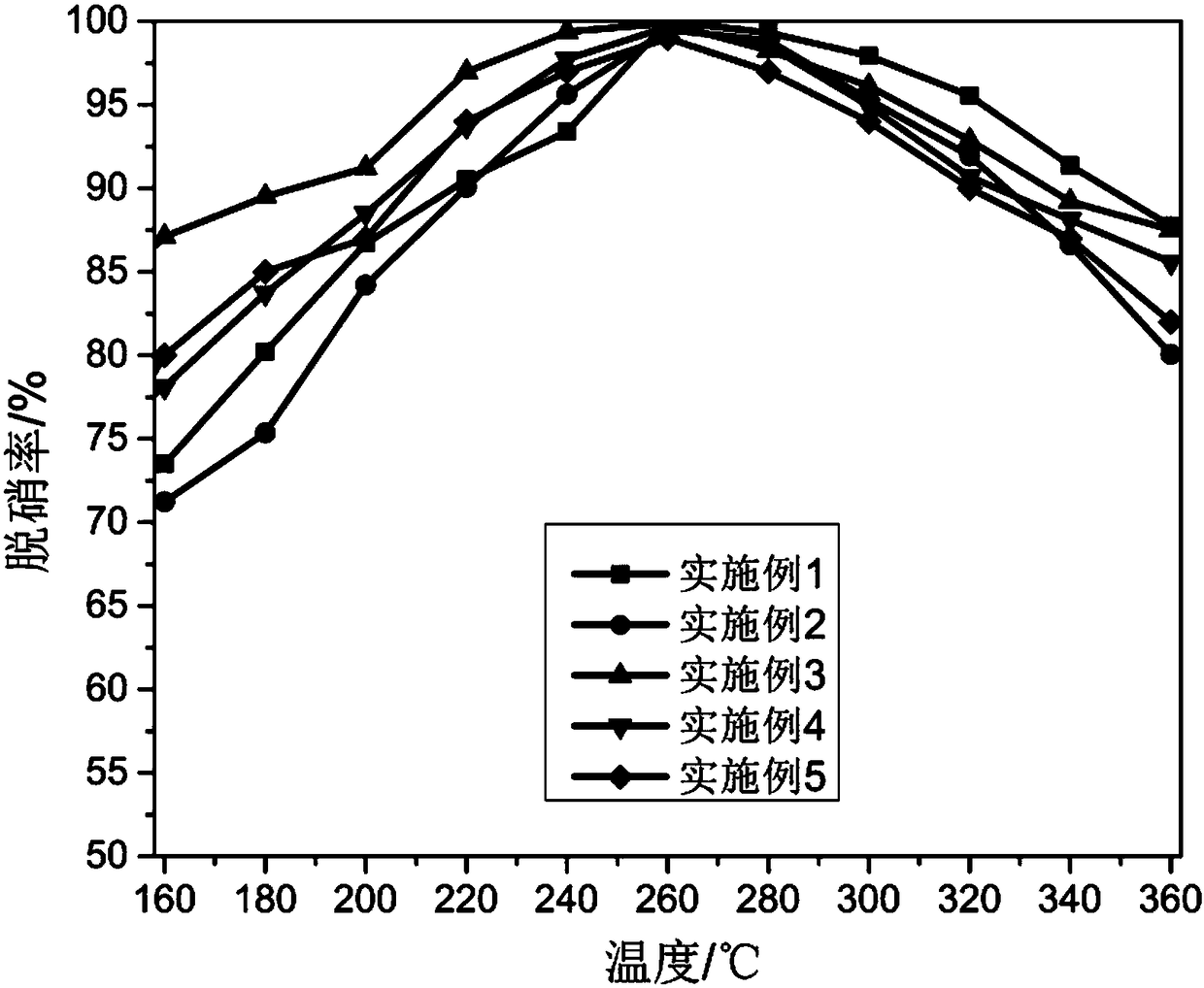Denitration catalyst
A denitration catalyst and catalyst technology are applied in the field of denitration catalysts, which can solve the problems of catalyst poisoning reaction and catalyst deactivation, and achieve the effects of promoting the occurrence of the reaction, high catalytic activity, and preventing S poisoning.
- Summary
- Abstract
- Description
- Claims
- Application Information
AI Technical Summary
Problems solved by technology
Method used
Image
Examples
Embodiment 1
[0026] S1. Preparation of Ti sol: Mix 15wt% tetrabutyl titanate, 2wt% hexadecyltrimethylammonium bromide, and 72wt% absolute ethanol and place them in a 90kHz ultrasonic wave for 0.5h. After stirring, take 11wt% distilled water was added dropwise to the above mixed solution and placed in an ultrasonic wave to continue stirring for 0.5h. The above two stirring stages were fed with N2 at a flow rate of 10mL / min, and the stirring temperature was 20°C;
[0027] S2. Put the Ti sol treated in step S1 in an environment with a temperature of 5° C., immerse the formed foam ceramics with a pore size of 50 nm in the Ti sol for 24 hours, then take out the foam ceramics and place them in a vacuum drying oven for 4 hours, and dry them. The temperature is 110°C;
[0028] S3. Continue to immerse the sample treated in step S2 in the Ti sol prepared in step S1, repeat step S2 twice, and then transfer the sample to a muffle furnace for sintering at 200°C;
[0029] S4. Active material preparatio...
Embodiment 2
[0035] S1. Preparation of Ti sol: Take 17wt% tetrabutyl titanate, 5wt% cetyltrimethylammonium bromide, 65wt% absolute ethanol and mix them in a 70kHz ultrasonic wave for 1h. After the stirring is completed, take 13wt% distilled water was added dropwise to the above mixed solution and placed in an ultrasonic wave to continue stirring for 0.5h. The above two stirring stages were fed with N at a flow rate of 30mL / min. 2 , the stirring temperature is 20°C;
[0036] S2. Put the Ti sol treated in step S1 in an environment with a temperature of 5° C., immerse the formed foam ceramics with a pore size of 60 nm in the Ti sol for 20 hours, then take out the foam ceramics and place them in a vacuum drying oven for 6 hours, and dry them. The temperature is 120°C;
[0037] S3. Continue to immerse the sample treated in step S2 in the Ti sol prepared in step S1, repeat step S2 for 3 times, and then transfer the sample to a muffle furnace for roasting at 190°C;
[0038] S4. Active material ...
Embodiment 3
[0044] S1. Preparation of Ti sol: Mix 20wt% tetrabutyl titanate, 7wt% hexadecyltrimethylammonium bromide, and 60wt% absolute ethanol and place them in a 100kHz ultrasonic wave for 1 hour. After stirring, take 13wt % distilled water was added dropwise to the above mixed solution and placed in an ultrasonic wave to continue stirring for 1 h. The above two stirring stages were fed with N at a flow rate of 50 mL / min. 2 , the stirring temperature is 25°C;
[0045] S2. Put the Ti sol treated in step S1 in an environment with a temperature of 15° C., immerse the formed foam ceramics with a pore size of 50 nm in the Ti sol for 15 hours, then take out the foam ceramics and place them in a vacuum drying oven for 8 hours, and dry them. The temperature is 130°C;
[0046] S3. Continue to immerse the sample treated in step S2 in the Ti sol prepared in step S1, repeat step S2 for 5 times, and then transfer the sample to a muffle furnace for roasting at 200°C;
[0047] S4. Active material p...
PUM
| Property | Measurement | Unit |
|---|---|---|
| porosity | aaaaa | aaaaa |
Abstract
Description
Claims
Application Information
 Login to View More
Login to View More - R&D
- Intellectual Property
- Life Sciences
- Materials
- Tech Scout
- Unparalleled Data Quality
- Higher Quality Content
- 60% Fewer Hallucinations
Browse by: Latest US Patents, China's latest patents, Technical Efficacy Thesaurus, Application Domain, Technology Topic, Popular Technical Reports.
© 2025 PatSnap. All rights reserved.Legal|Privacy policy|Modern Slavery Act Transparency Statement|Sitemap|About US| Contact US: help@patsnap.com

